Search
- Page Path
- HOME > Search
- [English]
- Comparative Study of Reduced Graphene Oxide Aerogels and Films for Supercapacitor Electrodes
- Sunghee Choi, Seulgi Kim, Seojin Woo, Dongju Lee
- J Powder Mater. 2025;32(1):23-29. Published online February 28, 2025
- DOI: https://doi.org/10.4150/jpm.2024.00472
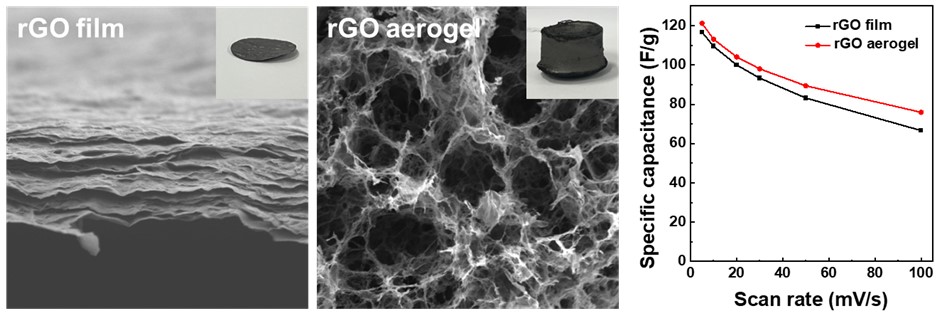
- 1,367 View
- 32 Download
-
 Abstract
Abstract
 PDF
PDF - Supercapacitors, renowned for their high power density and rapid charge-discharge rates, are limited by their low energy density. This limitation has prompted the need for advanced electrode materials. The present study investigated reduced graphene oxide (rGO) in two distinct structures, as a film and as an aerogel, for use as supercapacitor electrodes. The rGO film, prepared by vacuum filtration and thermal reduction, exhibited a compact, lamellar structure, while the aerogel, synthesized through hydrothermal treatment, was a highly porous three-dimensional network. Electrochemical analyses demonstrated the aerogel’s superior performance, as shown by a specific capacitance of 121.2 F/g at 5 mV/s, with 94% capacitance retention after 10,000 cycles. These findings emphasize the importance of structural design in optimizing ion accessibility and charge transfer. They also demonstrate the potential of rGO aerogels for increasing the energy storage efficiency of advanced supercapacitor systems.
- [Korean]
- Development of Highly Transparent and Thermo-Shielding Flexible Film via Colloidal ITO Nanocrystals
- Hyoin Bae, Hyeyeon Jung, Juna Lee, Dahye Shin, Sungyeon Heo
- J Powder Mater. 2024;31(6):508-512. Published online December 31, 2024
- DOI: https://doi.org/10.4150/jpm.2024.00423
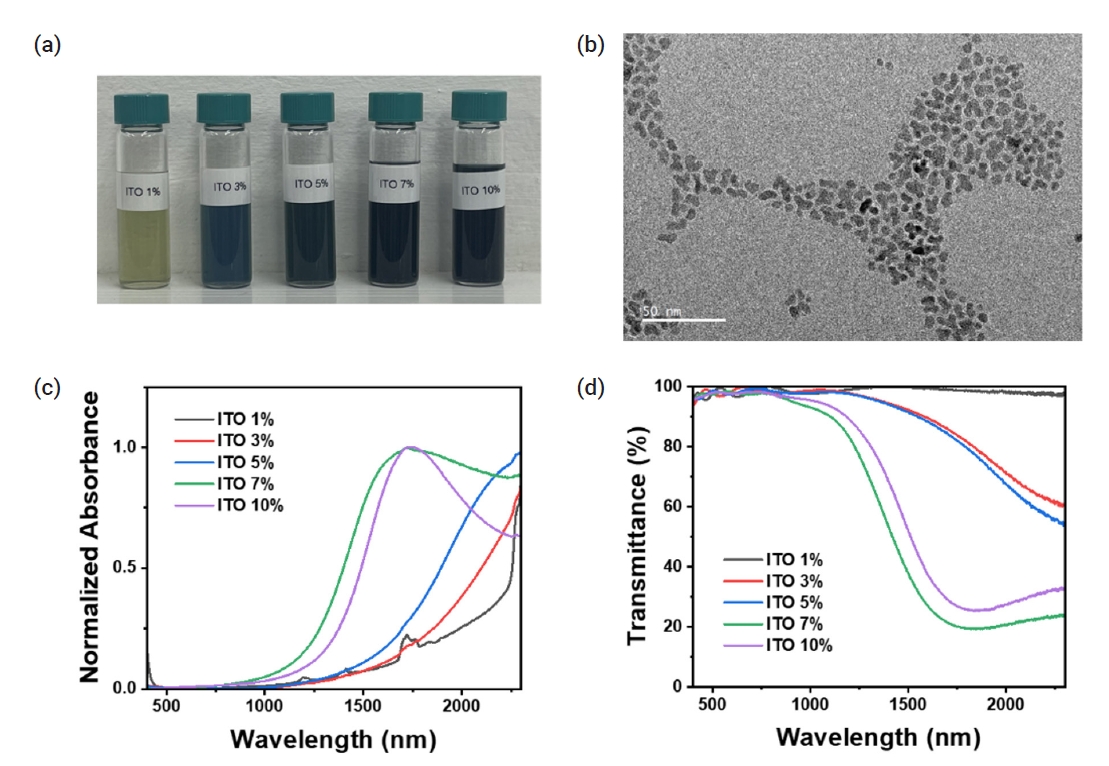
- 808 View
- 16 Download
-
 Abstract
Abstract
 PDF
PDF - Infrared radiation accounts for approximately 50% of the solar spectrum. Specifically, the near-infrared (NIR) spectrum, ranging from 760 nm to 2500 nm, is primarily responsible for solar heat gain, increasing indoor temperatures and reducing heating and cooling efficiency. To address this issue, we developed a highly transparent thermo-shielding flexible film that maintains a high transmittance of the visible region (T = 80%) while reducing the transmittance of the NIR region (T ≈ 0%). NIR-absorbing indium tin oxide (ITO) nanocrystals were coated onto polyethylene terephthalate (PET) films, and both films were sandwiched to improve the NIR absorption properties and protect the nanocrystal film layer. The fabricated films were applied to a model house and decreased the indoor temperature by approximately 8°C. Our study demonstrates that energy consumption can be reduced by ITO nanocrystal-coated flexible films, with potential implications for the smart window and mobility markets.
- [Korean]
- TiO2 Thin Film Coating on an Nb-Si–Based Superalloy via Atomic Layer Deposition
- Ji Young Park, Su Min Eun, Jongmin Byun, Byung Joon Choi
- J Powder Mater. 2024;31(3):255-262. Published online June 27, 2024
- DOI: https://doi.org/10.4150/jpm.2024.00052
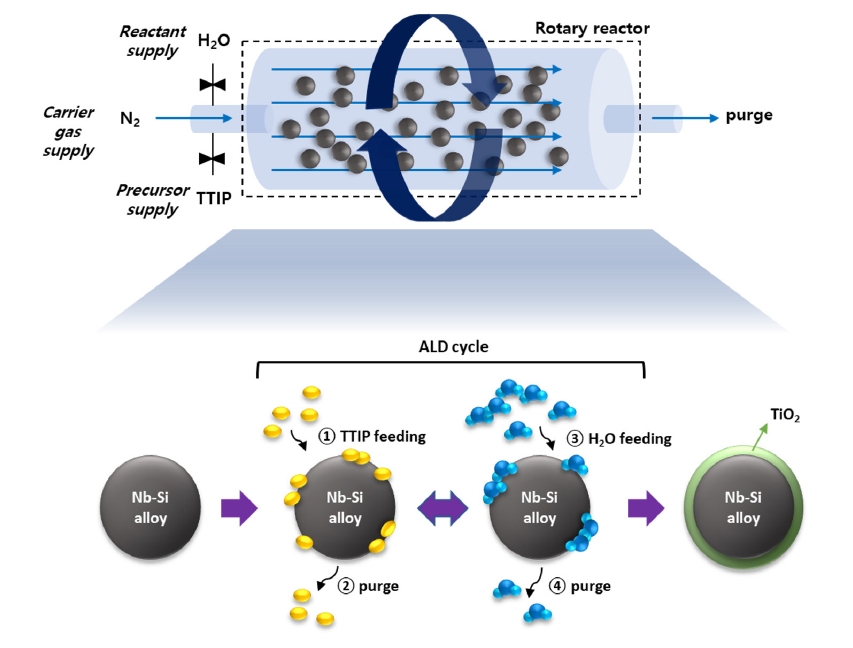
- 1,864 View
- 49 Download
-
 Abstract
Abstract
 PDF
PDF - Nano-oxide dispersion–strengthened (ODS) superalloys have attracted attention because of their outstanding mechanical reinforcement mechanism. Dispersed oxides increase the material’s strength by preventing grain growth and recrystallization, as well as increasing creep resistance. In this research, atomic layer deposition (ALD) was applied to synthesize an ODS alloy. It is useful to coat conformal thin films even on complex matrix shapes, such as nanorods or powders. We coated an Nb-Si–based superalloy with TiO2 thin film by using rotary-reactor type thermal ALD. TiO2 was grown by controlling the deposition recipe, reactor temperature, N2 flow rate, and rotor speed. We could confirm the formation of uniform TiO2 film on the surface of the superalloy. This process was successfully applied to the synthesis of an ODS alloy, which could be a new field of ALD applications.
- [Korean]
- Capacitance Enhancement and Evaluation of Gold-Deposited Carbon Nanotube Film Ion-Selective Electrode
- Do Youn Kim, Hanbyeol Son, Hyo-Ryoung Lim
- J Powder Mater. 2023;30(4):310-317. Published online August 1, 2023
- DOI: https://doi.org/10.4150/KPMI.2023.30.4.310
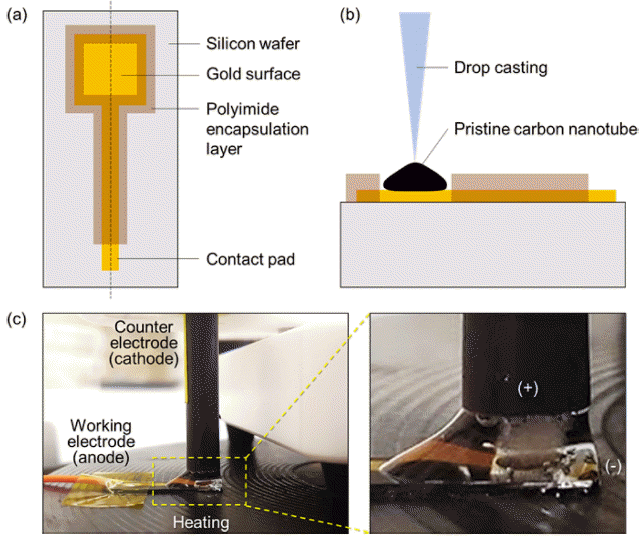
- 797 View
- 7 Download
-
 Abstract
Abstract
 PDF
PDF Small-film-type ion sensors are garnering considerable interest in the fields of wearable healthcare and home-based monitoring systems. The performance of these sensors primarily relies on electrode capacitance, often employing nanocomposite materials composed of nano- and sub-micrometer particles. Traditional techniques for enhancing capacitance involve the creation of nanoparticles on film electrodes, which require cost-intensive and complex chemical synthesis processes, followed by additional coating optimization. In this study, we introduce a simple one-step electrochemical method for fabricating gold nanoparticles on a carbon nanotube (Au NP–CNT) electrode surface through cyclic voltammetry deposition. Furthermore, we assess the improvement in capacitance by distinguishing between the electrical double-layer capacitance and diffusion-controlled capacitance, thereby clarifying the principles underpinning the material design. The Au NP–CNT electrode maintains its stability and sensitivity for up to 50 d, signifying its potential for advanced ion sensing. Additionally, integration with a mobile wireless data system highlights the versatility of the sensor for health applications.
- [Korean]
- Fabrication of compact surface structure by molar concentration on Sb-doped SnO2 transparent conducting films
- Ju-Won Bae, Bon-Ryul Koo, Hyo-Jin Ahn
- J Korean Powder Metall Inst. 2018;25(1):54-59. Published online February 1, 2018
- DOI: https://doi.org/10.4150/KPMI.2018.25.1.54
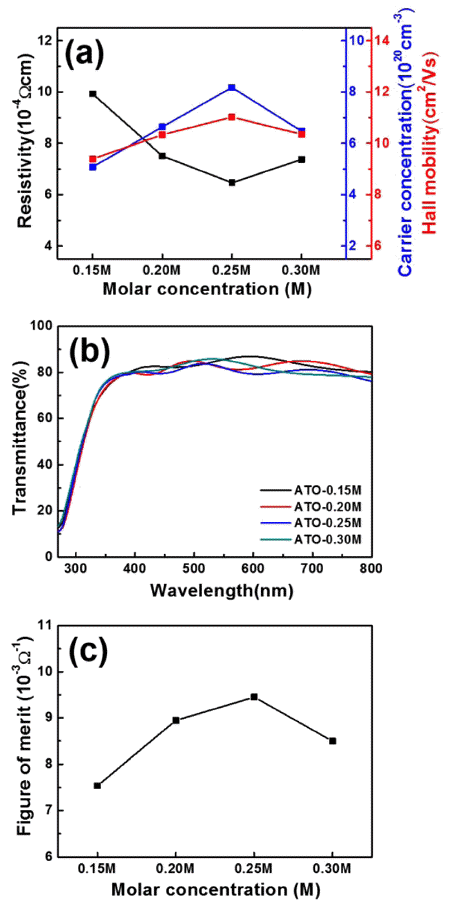
- 658 View
- 2 Download
-
 Abstract
Abstract
 PDF
PDF Sb-doped SnO2 (ATO) transparent conducting films are fabricated using horizontal ultrasonic spray pyrolysis deposition (HUSPD) to form uniform and compact film structures with homogeneously supplied precursor solution. To optimize the molar concentration and transparent conducting performance of the ATO films using HUSPD, we use precursor solutions of 0.15, 0.20, 0.25, and 0.30 M. As the molar concentration increases, the resultant ATO films exhibit more compact surface structures because of the larger crystallite sizes and higher ATO crystallinity because of the greater thickness from the accelerated growth of ATO. Thus, the ATO films prepared at 0.25 M have the best transparent conducting performance (12.60±0.21 Ω/□ sheet resistance and 80.83% optical transmittance) and the highest figure-of-merit value (9.44±0.17 × 10-3 Ω-1). The improvement in transparent conducting performance is attributed to the enhanced carrier concentration by the improved ATO crystallinity and Hall mobility with the compact surface structure and preferred (211) orientation, ascribed to the accelerated growth of ATO at the optimized molar concentration. Therefore, ATO films fabricated using HUSPD are transparent conducting film candidates for optoelectronic devices.
- [Korean]
- A Study on the Wear Properties of Cu-free Ecofriendly Vehicle Brake Pad
- Ki-Bong Kim, Sangsun Yang, Seong-Ju Lee, Suk-Hun Hwang, Sin-Wook Kim, Yong-Jin Kim
- J Korean Powder Metall Inst. 2018;25(1):30-35. Published online February 1, 2018
- DOI: https://doi.org/10.4150/KPMI.2018.25.1.30
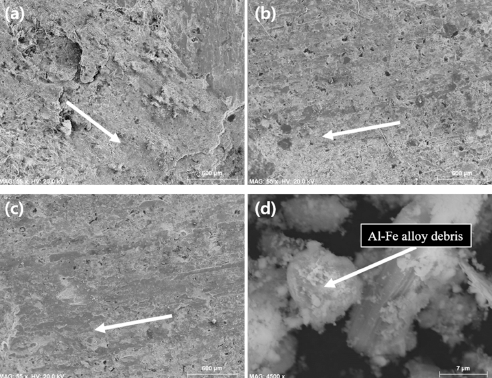
- 532 View
- 4 Download
-
 Abstract
Abstract
 PDF
PDF The friction characteristics of Al-Fe alloy powders are investigated in order to develop an eco-friendly friction material to replace Cu fiber, a constituent of brake-pad friction materials. Irregularly shaped Al-Fe alloy powders, prepared by gas atomization, are more uniformly dispersed than conventional Cu fiber on the brake pad matrix. The wear rate of the friction material using Al-8Fe alloy powder is lower than that of the Cu fiber material. The change in friction coefficient according to the friction lap times is 7.2% for the Cu fiber, but within 3.8% for the Al-Fe alloy material, which also shows excellent judder characteristics. The Al-Fe alloy powders are uniformly distributed in the brake pad matrix and oxide films of Al and Fe are homogeneously formed at the friction interface between the disc and pad, thus exhibiting excellent friction and lubrication characteristics. The brake pad containing Al-Fe powders avoids contamination by Cu dust, which is generated during braking, by replacing the Cu fiber while maintaining the friction and lubrication performance.
- [English]
- Fabrication and Characterization of Thermal Battery using Porous MgO Separator Infiltrated with Li based Molten Salts
- Kyungho Kim, Sungmin Lee, Chae-Nam Im, Seung-Ho Kang, Hae-Won Cheong, Yoonsoo Han
- J Korean Powder Metall Inst. 2017;24(5):364-369. Published online October 1, 2017
- DOI: https://doi.org/10.4150/KPMI.2017.24.5.364
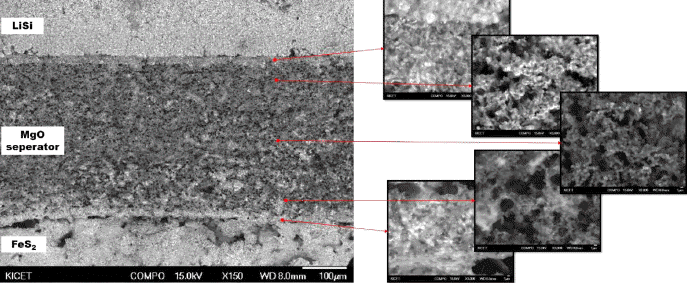
- 684 View
- 6 Download
-
 Abstract
Abstract
 PDF
PDF Ceramic powder, such as MgO, is added as a binder to prepare the green compacts of molten salts of an electrolyte for a thermal battery. Despite the addition of a binder, when the thickness of the electrolyte decreases to improve the battery performance, the problem with the unintentional short circuit between the anode and cathode still remains. To improve the current powder molding method, a new type of electrolyte separator with porous MgO preforms is prepared and characteristics of the thermal battery are evaluated. A Spherical PMMA polymer powder is added as a pore-forming agent in the MgO powder, and an organic binder is used to prepare slurry appropriate for tape casting. A porous MgO preform with 300 μm thickness is prepared through a binder burnout and sintering process. The particle size of the starting MgO powder has an effect, not on the porosity of the porous MgO preform, but on the battery characteristics. The porosity of the porous MgO preforms is controlled from 60 to 75% using a pore-forming agent. The batteries prepared using various porosities of preforms show a performance equal to or higher than that of the pellet-shaped battery prepared by the conventional powder molding method.
- [Korean]
- The Effect of Diffusion Barrier and thin Film Deposition Temperature on Change of Carbon Nanotubes Length
- Soon-kyu Hong, Hyung Woo Lee
- J Korean Powder Metall Inst. 2016;24(3):248-253. Published online June 1, 2016
- DOI: https://doi.org/10.4150/KPMI.2017.24.3.248

- 505 View
- 1 Download
- 2 Citations
-
 Abstract
Abstract
 PDF
PDF In this study, we investigate the effect of the diffusion barrier and substrate temperature on the length of carbon nanotubes. For synthesizing vertically aligned carbon nanotubes, thermal chemical vapor deposition is used and a substrate with a catalytic layer and a buffer layer is prepared using an e-beam evaporator. The length of the carbon nanotubes synthesized on the catalytic layer/diffusion barrier on the silicon substrate is longer than that without a diffusion barrier because the diffusion barrier prevents generation of silicon carbide from the diffusion of carbon atoms into the silicon substrate. The deposition temperature of the catalyst and alumina are varied from room temperature to 150°C, 200°C, and 250°C. On increasing the substrate temperature on depositing the buffer layer on the silicon substrate, shorter carbon nanotubes are obtained owing to the increased bonding force between the buffer layer and silicon substrate. The reason why different lengths of carbon nanotubes are obtained is that the higher bonding force between the buffer layer and the substrate layer prevents uniformity of catalytic islands for synthesizing carbon nanotubes.
-
Citations
Citations to this article as recorded by- A Study on Residual Powder Removing Technique of Multi-Layered Graphene Based on Graphene One-Step Transfer Process
Chae-young Woo, Yeongsu Jo, Soon-kyu Hong, Hyung Woo Lee
Journal of Korean Powder Metallurgy Institute.2019; 26(1): 11. CrossRef - Fabrication of robust, ultrathin and light weight, hydrophilic, PVDF-CNT membrane composite for salt rejection
Vivek Dhand, Soon Kyu Hong, Luhe Li, Jong-Man Kim, Soo Hyung Kim, Kyong Yop Rhee, Hyung Woo Lee
Composites Part B: Engineering.2019; 160: 632. CrossRef
- A Study on Residual Powder Removing Technique of Multi-Layered Graphene Based on Graphene One-Step Transfer Process
- [Korean]
- Fabrication and Property Evaluation of Cu-Mn Compacts for Sputtering Target Application by a Pulsed Current Activated Sintering Method
- Jun-Ho Jang, Ik-Hyun Oh, Jae-Won Lim, Hyun-Kuk Park
- J Korean Powder Metall Inst. 2016;23(1):1-7. Published online February 1, 2016
- DOI: https://doi.org/10.4150/KPMI.2016.23.1.1
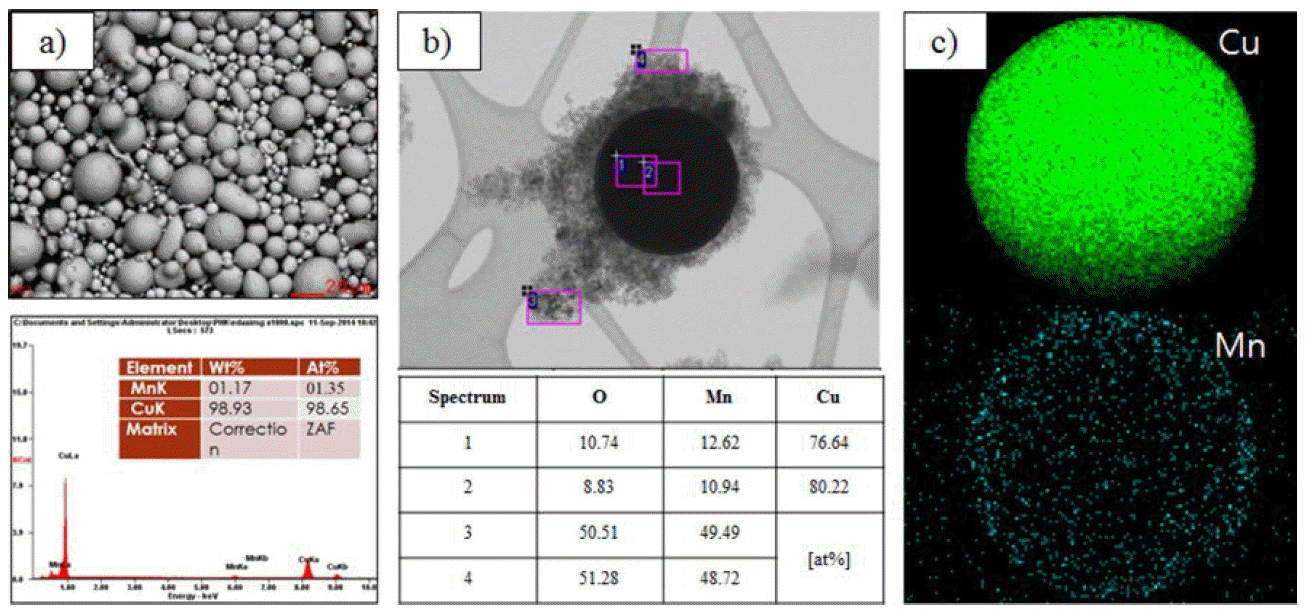
- 1,020 View
- 1 Download
- 1 Citations
-
 Abstract
Abstract
 PDF
PDF Cu-Mn compacts are fabricated by the pulsed current activated sintering method (PCAS) for sputtering target application. For fabricating the compacts, optimized sintering conditions such as the temperature, pulse ratio, pressure, and heating rate are controlled during the sintering process. The final sintering temperature and heating rate required to fabricate the target materials having high density are 700°C and 80°C/min, respectively. The heating directly progresses up to 700°C with a 3 min holding time. The sputtering target materials having high relative density of 100% are fabricated by employing a uniaxial pressure of 60 MPa and a sintering temperature of 700°C without any significant change in the grain size. Also, the shrinkage displacement of the Cu-Mn target materials considerably increases with an increase in the pressure at sintering temperatures up to 700°C.
-
Citations
Citations to this article as recorded by- Fabrication and Mechanical Property of Fe-20Cu-1C Compacts by SPS process with Different Heating Rate
Jung-Han Ryu, Soo-Sik Shin, Byung-Rok Ryu, Kyung-Sik Kim, Jun-Ho Jang, Ik-Hyun Oh, Kap-Tae Kim, Hyun-Kuk Park
Journal of Korean Powder Metallurgy Institute.2017; 24(4): 302. CrossRef
- Fabrication and Mechanical Property of Fe-20Cu-1C Compacts by SPS process with Different Heating Rate
- [Korean]
- Controlling Structural and Electrical Properties of Pt Nanopowder-Dispersed SiO2 Film
- Jae Ho Lee, In Joo Shin, Sung Woo Lee, Hyeong Cheol Kim, Byung Joon Choi
- J Korean Powder Metall Inst. 2014;21(5):355-359. Published online October 1, 2014
- DOI: https://doi.org/10.4150/KPMI.2014.21.5.355
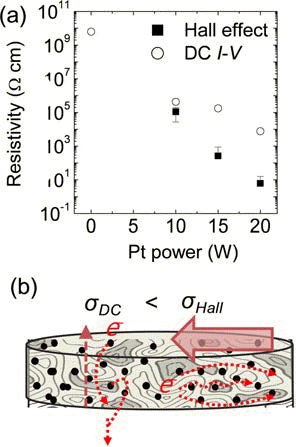
- 468 View
- 0 Download
-
 Abstract
Abstract
 PDF
PDF Pt nanopowder-dispersed SiO2 (SOP) films were prepared by RF co-sputtering method using Pt and SiO2 targets in Ar atmosphere. The growth rate and Pt content in the film were controlled by means of manipulating the RF power of Pt target while that of SiO2 was fixed. The roughness of the film was increased with increasing the power of Pt target, which was mainly due to the increment of the size and planar density of Pt nanopowder. It was revealed that SOP film formed at 10, 15, 20 W of Pt power contained 2.3, 2.7, and 3.0 nm of spherical Pt nanopowder, respectively. Electrical conductivity of SOP films was exponentially increased with increasing Pt power as one can expect. Interestingly, conductivity of SOP films from Hall effect measurement was greater than that from DC
I-V measurement, which was explained by the significant increase of electron density.
TOP
 KPMI
KPMI


 First
First Prev
Prev


